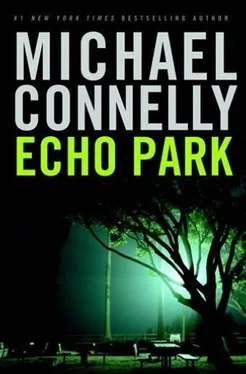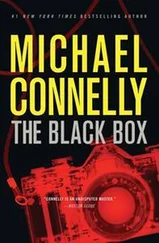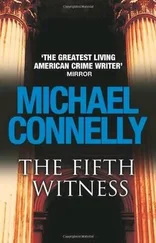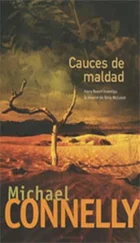Bosch went back to the investigative file. No matter the question of the legality of the traffic stop, the investigation of Raynard Waits had moved rapidly. The morning after the arrest Olivas and Colbert obtained a search warrant for the apartment on Sweetzer where Waits lived alone. A four-hour search and Forensics examination of the apartment produced several samples of human hair and blood taken from the bathroom’s sink and tub traps, as well as a hidden space beneath the floor containing several pieces of women’s jewelry and multiple Polaroid photos of nude young women who appeared to be sleeping, unconscious or dead. In a utility room was an upright freezer which was empty, except for the two samples of pubic hair found by an SID tech.
Meantime, the three plastic bags found in the van had been transported to the coroner’s office and opened. They were found to contain the body parts of two young women, each of whom had been strangled and dismembered after death in the same way. Of note was the fact that the parts from one of the bodies showed indications of having been thawed after being frozen.
Though no cutting tools were found in Waits’s apartment or van, it was clear from the evidence gathered that while Officers Gonzalez and Fennel were looking for a burglar, they had stumbled onto what appeared to be a serial killer at work. The belief was that Waits had already discarded or hidden his tools and was in the process of disposing of the bodies of the two victims when he drew the attention of the CRT officers. The indications were that there might be other victims as well. The reports in the file detailed the efforts made in the next several weeks to identify the two bodies as well as the other women in the Polaroids found in the apartment. Waits of course offered no help in this regard, engaging the services of Maury Swann on the morning of his capture and choosing to remain silent as the law enforcement processes continued and Swann mounted an attack on the probable cause of the traffic stop.
Only one of the two known victims was identified. Fingerprints taken from one of the dismembered women drew a hit on the FBI’s latent database. She was identified as a seventeen-year-old runaway from Davenport, Iowa. Lindsey Mathers had left home two months before being found in Waits’s van and had not been heard from during that time by her parents. With photos supplied by her mother, detectives were able to piece together her trail in Los Angeles. She was recognized by youth counselors at several Hollywood shelters. She had been using a variety of names to avoid being identified and possibly sent home. There were indications she was involved in drug use and street prostitution. Needle marks found on her body during the autopsy were believed to have been the result of a long and ongoing practice of injecting drugs. A blood screen taken during the autopsy found heroin and PCP in her bloodstream.
The shelter counselors who helped identify Lindsey Mathers were also shown the Polaroid photographs found in Waits’s apartment and were able to provide a variety of different names for at least three of the women. Their stories were similar to Mathers’s journey. They were runaways possibly engaged in prostitution as a means of earning money for drugs.
It was clear to Bosch from the gathered evidence and information that Waits was a predator who targeted young women who would not be immediately missed, fringe dwellers who were unaccounted for by society in the first place and therefore not missed when they disappeared.
The Polaroids from the hidden space in Waits’s apartment were in the file, encased in plastic sheets, four to a page. There were eight pages with multiple shots of each woman. An accompanying analysis report stated that the photo collection contained shots of nine different women-the two women whose remains were found in Waits’s van and seven unknowns. Bosch knew that the unknowns were likely to be the seven women Waits was offering to tell authorities about in addition to Marie Gesto and the pawnshop man, but he studied the photos anyway for the face of Marie Gesto.
She wasn’t there. The faces in the photos belonged to women who had not caused the same sort of stir that Marie Gesto had. Bosch sat back and took off his reading glasses to rest his eyes for a few moments. He remembered one of his early teachers in Homicide. Detective Ray Vaughn had a special sympathy for the ones he called “murder’s nobodies,” the victims who didn’t count. He taught Bosch early on that in society all victims are not created equal, but to the true detective they must be.
“Every one of them was somebody’s daughter,” Ray Vaughn had told him. “Every one of them counted.”
Bosch rubbed his eyes. He thought about Waits’s offer to clear up nine murders, including Marie Gesto’s and Daniel Fitzpatrick’s and those of seven women who never caused a blip on anybody’s radar. Something seemed not right about that. Fitzpatrick was an anomaly because he was a male and the killing didn’t appear to be sexually motivated. He had always assumed that Marie Gesto was a sex killing. But she was not a throwaway victim. She had hit the radar big time. Had Waits learned from her? Had he honed his craft after her killing to make sure he never drew such police and media heat again? Bosch thought that maybe the heat he had applied on the Gesto case was what caused Waits to change, to become a more skilled and cunning killer. If that was so, then he would have to deal with that guilt at a later time. For now he had to focus on what was in front of him.
He put his glasses on again and went back to the files. The evidence against Waits was solid. Nothing like being caught in possession of body parts. A defense attorney’s nightmare; a prosecutor’s dream. The case sailed through a preliminary hearing in four days, and then the DA’s office upped the ante with O’Shea announcing he would go for the death penalty.
Bosch had a legal pad to the side of the open file so that he could write down questions for O’Shea, Waits or others. It was blank when he came to the end of his review of the investigation and prosecution files. He now wrote the only questions that came to mind.
If Waits killed Gesto, why was there no photo of her in his apartment?
Waits lived in West Hollywood. What was he doing in Echo Park?
The first question could be easily explained. Bosch knew killers evolved. Waits could have learned from the Gesto killing that he needed reminders of his work. The photos could have started after Gesto.
The second question was more troubling to him. There was no report in the file that dealt with this question. It was thought simply that Waits had been on his way to get rid of the bodies, possibly to bury them in the parklands that surrounded Dodger Stadium. No further investigation of this was contemplated or called for. But to Bosch it was something to consider. Echo Park would have been at least a half hour away by car from Waits’s apartment in West Hollywood. That was a long time to be driving with body parts in bags. Additionally, Griffith Park, which was larger and had more pockets of isolated and difficult terrain than the area around the stadium, was far closer to the West Hollywood apartment and would have been the better choice for a body dump.
To Bosch it meant that Waits had a specific destination in mind in Echo Park. This had been missed or dismissed as unimportant in the original investigation.
He next wrote two words.
psych profile?
No psychological study of the defendant had been conducted and Bosch was mildly surprised by this. Perhaps, he thought, it had been a strategic decision by the prosecution. O’Shea might have chosen not to take this route because he didn’t know exactly where it would lead. He wanted to try Waits on the facts and send him to the death chamber. He didn’t want to be responsible for opening a door to a possible insanity defense.
Читать дальше












